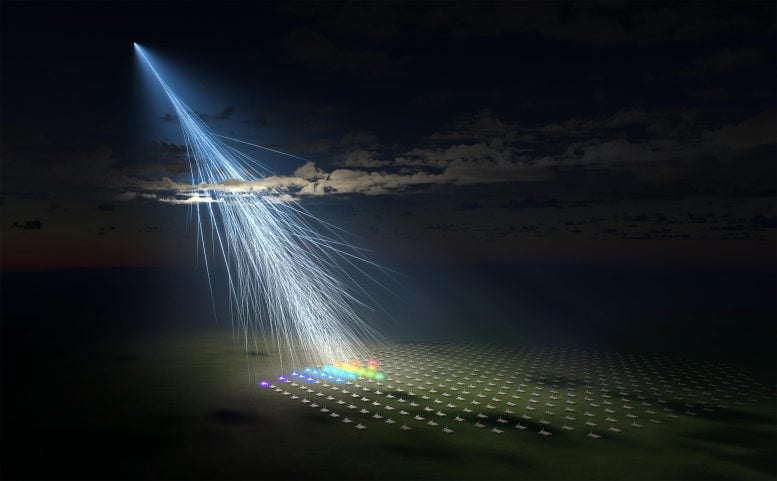Telescope Array Discovers Enigmatic Ultra-High Energy Extraterrestrial Particle with an Unidentified Origin

An illustration by an artist depicting the considerably energetic cosmic ray observed by the Telescope Array experiment's surface detector array, referred to as "Amaterasu particle," has been credited to Osaka Metropolitan University/L-INSIGHT, Kyoto University/Ryuunosuke Takeshige.
The Telescope Array experiment's detection of an extraordinarily energetic cosmic ray presents an intriguing puzzle about its source, as it seems to originate from a cosmic void. This observation contradicts current theories on the origins of cosmic rays and high-energy physics.
The researchers behind the Telescope Array experiment have reported the detection of a remarkably energetic cosmic ray. This particle, which originated beyond our galaxy, carries a striking energy level of more than 240 exa-electron volts (EeV). However, the exact source of this remarkable discovery remains unknown, as its direction does not align with any known astronomical entities.
Cosmic rays are charged subatomic particles from space. Among these, Ultrahigh-energy cosmic rays (UHECRs) hold a special place due to their rare and extraordinarily powerful nature. Their energies exceed 1 EeV, which is roughly a million times higher than the energy levels achieved by manmade particle accelerators. UHECRs are thought to originate from the Universe's most energetic phenomena, such as black holes, gamma-ray bursts, and active galactic nuclei. The precise physics and acceleration mechanisms of these particles, however, remain a mystery. Their detection is a rare occurrence due to their infrequency, necessitating the use of devices with vast collection areas.
An artist’s illustration of ultra-high-energy cosmic ray astronomy clarifies highly energetic phenomena, contrasted to a weaker cosmic ray affected by electromagnetic fields. This has been credited to Osaka Metropolitan University/Kyoto University/Ryuunosuke Takeshige.
On May 27, 2021, the Telescope Array (TA) experiment – an extensive surface detector array in Utah covering an effective detection area of 700 square kilometers – successfully detected a UHECR with an unprecedented energy of around 244 EeV.
Given the extraordinary energy of the particle, the researchers highlight that it should only experience relatively minor deflections by foreground magnetic fields. Therefore, its source should correlate closely with its arrival direction. However, the data shows no obvious source galaxy or any other known astronomical objects that could be potential UHECR sources in the direction of its arrival.
The arrival direction of the particle instead points back to a void in the Universe's large-scale structure – an area housing very few galaxies. The scientists propose that this observation could indicate a much larger magnetic deflection than what current galactic magnetic field models predict. Alternatively, it may imply an unidentified source in the local extragalactic neighborhood or an incomplete understanding of high-energy particle physics.




